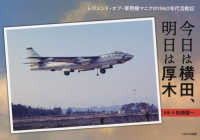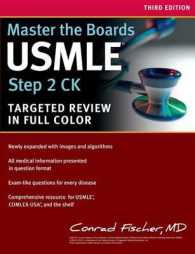- ホーム
- > 洋書
- > ドイツ書
- > Mathematics, Sciences & Technology
- > Biology
Full Description
Physiology and biochemistry of male reproductive function and semen became the main area of my research in 1944, after my attention was finally diverted frorp. animal cells in general, to mammalian spermatozoa specifically‾ Ever since, the interest has remained largely focussed on reproductive probletns in mammals, the work continuing mostly at the University of Cambridge, where I was privileged to hold also the Marshall Walton Professorship in Physiology of Reproduction. This work led to the publication of three books, The Biochemistry of Semen (Methuen 1954), The Biochemistry of Semen and of the Male Reproductive Tract (Methuen 1964) and lately, in co authorship with my wife, Dr. Cecilia Lutwak-Mann, Male Re productive Function and Semen - Themes and Trends in Phys iology, Biochemistry and Investigative Andrology (Springer Verlag 1981). In 1960, thanks to the Lalor Foundation, I was able to avail myself for the first time of a chance to visit the Marine Biological Laboratory at Woods Hole and there to take part in a study of reproduction in marine animals. Ever since, first as Visiting Professor of Biology at the State University of Florida, and later as the Walker Ames Professor and frequent visitor to the Department of Zoology at the University of Washington in Seattle, it has been my good fortune to sustain this pew interest and to pursue it further.
Contents
1. General Considerations.- 1.1 Beginnings.- 1.2 Definitions.- 1.3 Spermatophore as Repository and Transport Vehicle for Spermatozoa. Certain Similarity to Epididymis.- 1.4 Direct and Indirect Insemination Routes.- 1.5 Role of Spermatophore in Fertilization and Nutrition.- 1.6 Common Features of Spermatophore, Copulatory Plug, and Sphragis.- 1.7 Conflicting Views on the Origin and Purpose of Spermatophores.- 2. Platyhelminthes, Aschelminthes, and Phoronida.- 2.1 Early Observations on the Attachment of Spermatophores to the Skin of Turbellaria.- 2.2 Mechanisms of Sperm Transfer in Turbellaria and Monogenea.- 2.3 Hypodermic Impregnation in Rotifera and Other Aschelminthes.- 2.4 Spermatophores of Phoronis vancouverensis and Phoronopsis harmeri, and the Role of Lophophoral Organs in Phoronida.- 3. Mollusca.- 3.1 Gastropoda: Prosobranchia, Opisthobranchia, and Pulmonata.- 3.2 Cephalopoda: Main Features of Male Reproductive Function in Nautiloidea, Decapoda, Vampyromorpha, and Octopoda.- 3.3 Nautiloidea: Nautilus pompilius and Nautilus macromphalus.- 3.4 Decapoda: Loligo pealii, Rossia macrosoma, Rossia pacifica, Sepiola rondeletii, and Sepia officinalis.- 3.5 Small Octopoda: Octopus vulgaris, Octopus hummelincki, Octopus bimaculatus, Other Small Octopuses, Eledone moschata, and Eledone cirrhosa.- 3.6 The Giant Octopus of the North Pacific, Octopus dofleini martini.- 3.7 Biochemistry of the Giant Octopus Spermatophore.- 4. Annelida.- 4.1 Polychaeta, Including Myzostomaria, and Archiannelida.- 4.2 Oligochaeta.- 4.3 Hirudinea.- 5. Onychophora and Myriapoda.- 5.1 Dermal Copulation and Spermatophores in Onychophora.- 5.2 Production of Spermatophores in Pauropoda.- 5.3 Direct and Indirect Transfer of Spermatozoa in Diplopoda.- 5.4 Peculiar Ring Structure of Spermatophores and Indirect Sperm Transfer in Chilopoda.- 5.5 External Fertilization in Symphyla.- 6. Insecta.- 6.1 Insemination Routes and Sperm-Encompassing Devices.- 6.2 Male Genital System.- 6.3 Relationships Between Sperm-Cysts, Sperm-Bundles, Spermatodesms, Spermatozeugmata, Droplet Spermatophores, and Typical Spermatophores.- 6.4 Role of Male Accessory Secretions in the Production of Spermatophores.- 6.5 Some Unusual Chemical Constituents of Male Accessory Secretions, and Their Passage into the Semen and Spermatophores: Indolalkyl Amine, Fructose, Glucose, and Trehalose, Pyrophosphate, Uric Acid, Cyclic Guanosine 3?,5?-Monophosphate, and Prostaglandin Synthetase.- 6.6 Gustatory and Aphrodisiac Attributes of Male Secretory Products and Spermatophores.- 6.7 Droplet Spermatophores in Apterygotan Insects: Collembola, Diplura, and Thysanura.- 6.8 Typical Spermatophores and Different Mechanisms of Their Assembly in Pterygotan Insects.- 6.9 Mating Flights of Ephemeroptera and Odonata.- 6.10 Spermatophores of Orthopteroid Insects: Blattidae, Mantoidea, Phasmida, Gryllidae, Tettigoniidae, and Acrididae.- 6.11 Spermatophores of Hemiptera, Neuroptera, Coleoptera, Mecoptera, Trichoptera, Lepidoptera, Diptera, and Hymenoptera.- 7. Crustacea.- 7.1 Ostracoda.- 7.2 Copepoda: Harpacticoida, Calanoida, Cyclopoida, and Caligoida.- 7.3 Malacostraca: Isopoda, Cumacea, Mysidacea, Euphausiacea, and Decapoda.- 8. Arachnida.- 8.1 Spermatophores and Sperm Transfer Mechanisms in Arachnids.- 8.2 Scorpiones.- 8.3 Pseudoscorpiones.- 8.4 Uropygi — Thelyphonida — Holopeltidia.- 8.5 Amblypygi — Phrynichidea.- 8.6 Araneae.- 8.7 Acari: Water Mites (Hydrachnidae); Terrestrial Mites (Trombiculidae, Trombidiformes, Oribatei, and Eriophyidae); Ticks (Ixodidae and Argasidae).- 8.8 Triggering of SpermatophoricReaction in Ticks by Carbon Dioxide.- 8.9 Occurrence of Spermine in Tick Spermatophores.- 9. Chaetognatha and Pogonophora.- 9.1 Exchange of Spermatophores in Hermaphroditic Chaetognatha.- 9.2 Special Features of Spermatophore Function in Pogonophora.- 10. Sporadic Occurrence of Spermatophores and Spermatozeugmata in Vertebrata.- 10.1 The Difficulty of Naming Correctly Various Forms of Sperm-Aggregates.- 10.2 Chondrichthyes.- 10.3 Viviparous and Ovo-Viviparous Teleosti.- 10.4 Amphibia.- Concluding Remarks.








